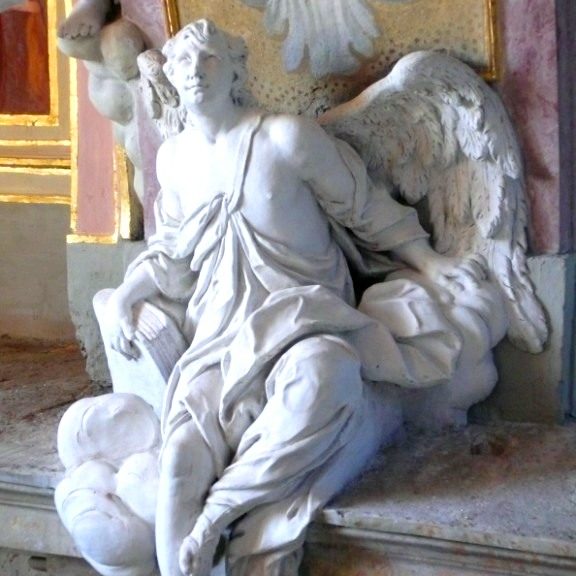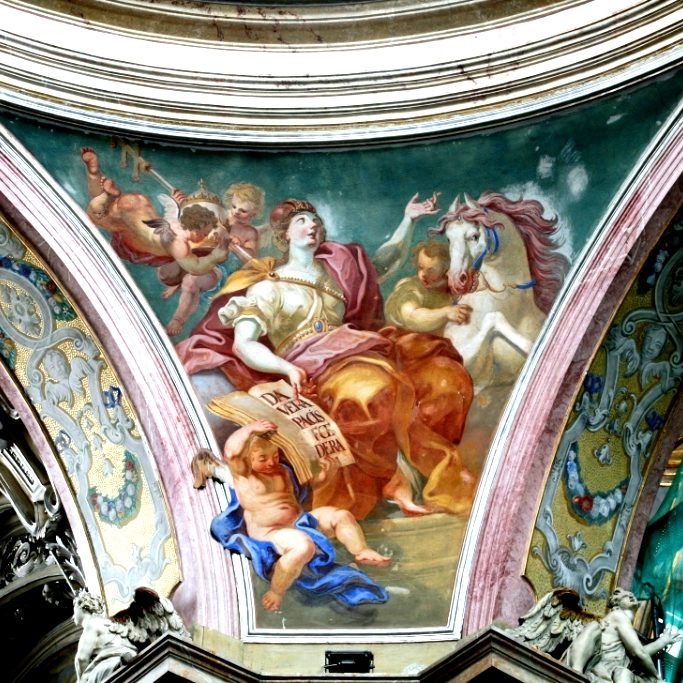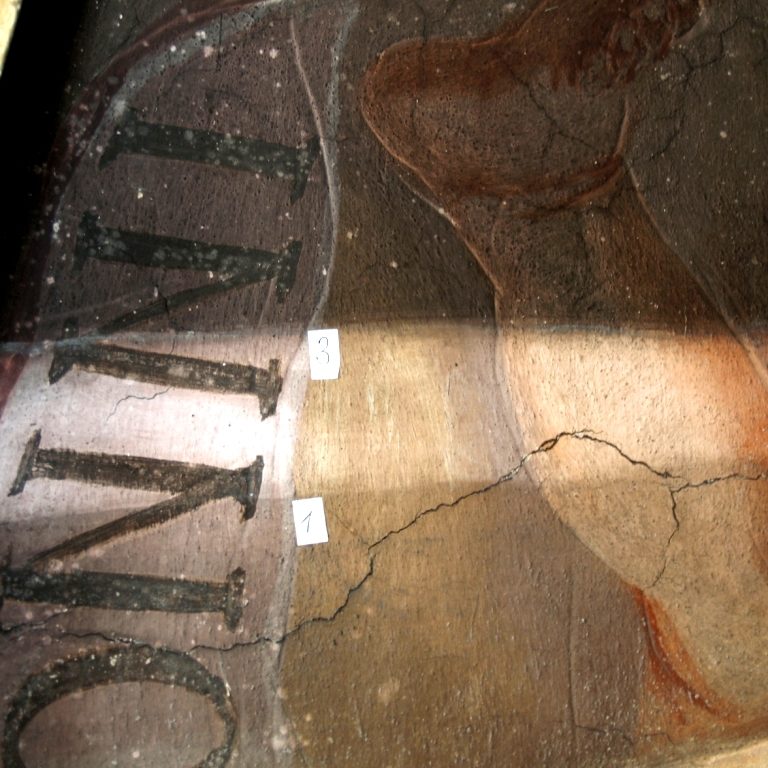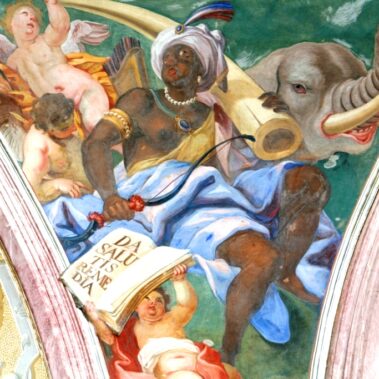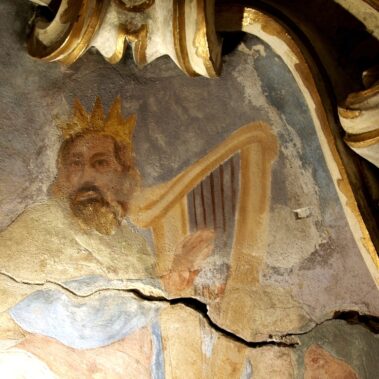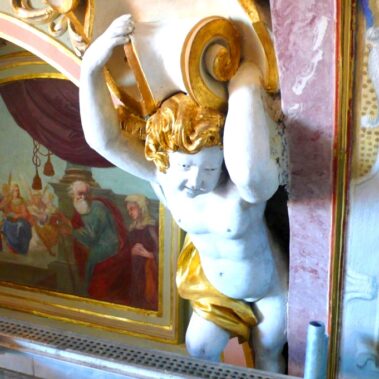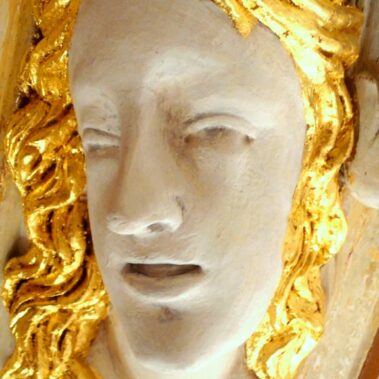Basilica Minor the Visitation of the Virgin Mary, Svatý Kopeček near Olomouc, Czech Republic

| Address: | Bazilika Navštívení Panny Marie na Svatém Kopečku, Sadové náměstí 1, 177900, Olomouc |
|---|---|
| Description of work: | Restoration of the painting and stucco decorations
Restoration of the artificial marbles Restoration of the sculptures |
| Contractor: | GEMA ART GROUP a.s. |
| Investor: | Royal Canonry of Premonstratensians, Strahov |
| Implementation: | 05/2007 – 01/2010 |
The origins of the pilgrimage site go back to 1629 when the building of a chapel first started. The impetus came from an Olomouc burgher, Jan Andrýsek, who, according to legend, had a vision of the Virgin Mary on the site. The land belonged to the nearby monastery of Hradisko, where the Order of Premonstratensians was resident. The abbot of the monastery and the Bishop of Olomouc agreed to the building, but the chapel had a short lifespan as it was burnt down by the Swedish army, plundering the Olomouc region, during the Thirty Years War. The chapel was soon restored but was too small for its purpose as pilgrims coming to Svatý Kopeček constantly grew in number. At the suggestion of the then abbot of the Hradisko monastery, Bedřich Sedlák – Sedlecius – a proposal was made to further the renown of the place by building a new capacious church. The building took the whole decade (1669 till 1679). The author of the design was the Swiss Italian architect Giovanni Pietro Tencalla who worked for the Olomouc bishopric. The church has a single nave structure with transepts, a central dome and several lateral chapels. In 1714 the Italian architect Domenico Martinelli added one story buildings to the sides of the church , intended for official and accommodation purposes. Further alterations took place between 1721 and 1732, when the church was given a new interior, the work of the Italian sculptor and stucco master Baldassar Fontana. Frescos by Johann Christoph Handke were added in 1731. The quality of the frescoes, stucco decorations and sculptural ornamentation in the Basilica of the Visitation of the Virgin Mary makes the church one of the most beautiful Baroque art interiors in Moravia.
After the dissolution of the monasteries during the 1784 reforms instigated under the rule of Joseph II Habsburg, the pilgrimage site fell into decline and the church deteriorated due to a lack of finance. The turning point came in 1846 when the Premonstratensians returned to Svatý Kopeček and the church came under the administration of the Strahov monastery. Significant renovations took place between 1930 and 1932, when electric lighting was installed. At the end of the World War II the church came under Red Army artillery fire and suffered far-reaching damage. The church spire took a hit and the shock caused cracks in the interior visible both in the paintings and the stucco. After the dissolution of male religious orders by the communist regime in 1950 , the church became the responsibility of the Olomouc Diocese. The Premonstratensian Order eventually returned to Svatý Kopeček after the 1989 revolution. The most important event in the modern history of the church was the visit by Pope John Paul II who awarded the site the status of Basilica Minor and thus took it under direct Papal patronage. Only 15 religious sites in the Czech Republic enjoy such a distinction. In recent years the Basilica of the Visitation of the Virgin Mary underwent almost complete renovation in which the company GEMA ART GROUP a.s. took a significant part.
Specialist tasks concerned mainly restoration of the paintings and the sculptural elements, gilding of the presbytery and interior restoration of the dome and the main nave. These were not the first interventions: restoration work had been carried out here in 1846 under the leadership of Josef Faber but as a consequence of using unsuitable materials these repairs were not very sympathetic. Further work took place from 1941 till 1943 and in 1945.
The extensiveness and high artistic quality of the decoration within the church make it one of the most imposing Baroque interiors in Moravia and calls for its salvation have been heard for many years. The decoration was in a highly unsatisfactory, and in places, even a critical state. Stuccoes had become loose in several locations and the colour of the frescoes had deteriorated due to dirt deposits. Structural fissures in the ornamentation caused by artillery bombardment by the Red Army at the end of the World War II presented a serious problem. The worst situation was in the chapel where the frescoes were covered by oil based paint and also suffered serious damage caused by leaking rain water. The surface layer of the plaster had in places become detached from the base causing cracks and crevices and in some parts loss of plaster altogether. The leaks also created dark patches. The sculptural ornamentation was in places cracked and broken and the experts had to resort in some cases to reconstruction of the missing parts.
The onset of the restoration work was preceded by meticulous research and detailed photo documentation. Non-invasive methods used included infra-red reflectography and inspection of the painting under strong side lighting. Macro samples for chemical analysis were also collected. According to the results of the research the state of the paintings, the degree of damage and the extent of salvageable originals were all evaluated.
The purpose of the work was to preserve the endangered parts of the ornamentation and in general recreate the original concept of the whole space. All interventions were subject to consultation with conservation experts. Apart from professional restoration work the company GEMA ART GROUP a.s. also organized the hire and installation of the scaffolding, and the protection of all parts underneath the scaffolding (such as the altar, the paintings and the sculptures) from any damage or loss.
Restoration work took place from May 2007 till January 2010 and the project raised considerable interest in the media.
Restoration of the frescoes:
Restoration of the frescoes pertained mainly to the areas of the main nave, the presbytery, the dome and the eight chapels. The experts encountered disturbance to frescoes due to grease and dirt deposits, minor to medium cracking and loss of plaster. The deposit layer distorted both the colours and the structure of the frescoes. During the restoration of the individual parts of the painting several techniques were used depending on varying colour content and size of the area and an overall harmony of the whole was always a consideration.
The surface of the frescoes was first mechanically cleaned using distilled water and a special India Rubber sponge suitable for dry cleaning of the frescoes. Disintegrated parts were consolidated using a water acrylic dispersion over Japanese tissue paper. In some parts of the paintings the application had to be repeated several times.
In some cases it was decided to remove more recent layers of over painting in order to preserve the original style of the interior. Defects were in-filled and re-touched using mineral pigments or oil paints.
A somewhat different approach was applied to the fresco restoration in the side chapels, which were more extensively damaged, for two main reasons: oil paint had been used during latter restorations and the roofs of the chapels suffered more damage than the roof over the main body of the church, which led to greater leakage of rain water and residual dampness inside the chapels which continued even after the roofs were repaired. The restorers first undertook a several weeks long dehumidification process using electric dehumidifiers. During the actual restoration of the frescoes in the chapels it became necessary to secure the worst affected parts right back to the foundation . The oil paint was consolidated using synthetic resins and a power spatula. All defects were in-filled in a similar way to the rest of the restored frescoes in the church.
Restoration of the stuccoes and the sculptural parts:
The stuccoes and the sculptural ornamentation in the main nave, the presbytery and the dome were in a reasonably good state. There was mostly localized minor damage such as cracks caused by masonry movement during the artillery attack by the Red Army in 1945 or by leaking rain water. The situation was much worse in the chapels, especially in the Chapel of the Guardian Angel, where the cracks caused by dampness were most extensive. Some parts of the stuccoes were also broken or disturbed.
The stucco decorations were first cleaned using distilled water, steam generator, brushes, vacuum cleaners and special sponges, thus removing the disintegrated layers of the paintings. A special water based chemical solution was used as a fixative. Missing parts of the stuccoes were replaced using a slaked lime based material. Coloured parts of the stuccoes were restored according to alterations made in the first half of the 18th century, using grey-green and darker grey shades originally found in the areas of the main nave, presbytery and the chapel. An ochre hue was chosen for the surrounding area of the frescoes in the lunettes.
Some sculptures also suffered localized damage. Pieces were broken off and due to the dampness in the chapels and the main nave the iron armatures holding parts of the sculptures together (such as the head, arms and legs) corroded away and the sculptures fell apart. It was necessary to take them to pieces, which were reconstructed, treated with an anti-corrosive agent and then glued back into the original form. Some later alterations were removed to restore the sculptures to their original appearance. The six sculptures of angels – cherubs, six putti on the cloud and the dove in the lantern of the dome were also restored back to their original form. The later-added silver paint was removed and replaced by the original ornamentation using pure gold.
Restoration of the artificial marbles:
Artificial red marble had been used in the window arches and parapets and this material exhibited small fissures prior to restoration. The cracks were in-filled, the whole area strengthened and treated with a special preparation and re-polished.
Restoration of the ornamental gilding:
In regard to restoration of the gilding, the work centred on the decoration in the vaulting of the main nave. The decorations in the chapels suffered a lesser degree of damage, with the exception of the Chapel of St Paula, where significant reconstruction took place. Originally, pure gold was used for the decoration but it was replaced later by aluminium. During the work the aluminium layer was removed using abrasive paper and minor defects in-filled using dispersive putty. 24-Carat gold was used for the gilding. Thanks to the efforts of the experts from the GEMA ART GROUP a.s. the interior of the basilica was returned to its original Baroque appearance.






